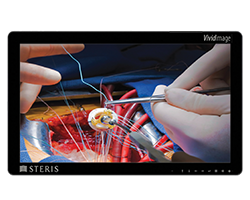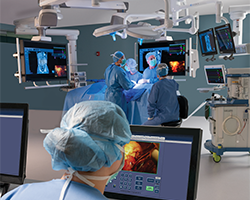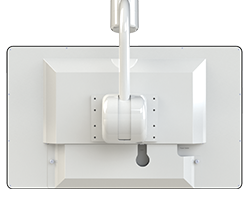What Are Surgical Displays?
Why Are Surgical Displays Important?
 Surgical displays are used to provide instant visualization of intricate patient anatomy during the surgery, displaying a crisp view of the surgical field. A surgical display also provides critical patient information to the surgical staff during a procedure, including vital signs and X-rays. This information helps surgeons and physicians make diagnoses and determine how best to treat the patient. Physicians commonly use surgical monitors during endoscope-guided procedures. Whether performing a gastrointestinal (GI), arthroscopic, laparoscopic or robotic-guided surgery, surgical displays allow the physician to view the patient’s anatomy throughout the procedure.
Surgical displays are used to provide instant visualization of intricate patient anatomy during the surgery, displaying a crisp view of the surgical field. A surgical display also provides critical patient information to the surgical staff during a procedure, including vital signs and X-rays. This information helps surgeons and physicians make diagnoses and determine how best to treat the patient. Physicians commonly use surgical monitors during endoscope-guided procedures. Whether performing a gastrointestinal (GI), arthroscopic, laparoscopic or robotic-guided surgery, surgical displays allow the physician to view the patient’s anatomy throughout the procedure.
Surgical displays should have the required certifications to be certified as a medical display. Medical grade displays are designed to be extremely durable, sealed and have high-quality panels to ensure the best image. A surgical display can mount to surgical light arms, equipment columns, or walls and may offer high-definition or 4K visualization.
Types of Surgical Displays

- Diagnostic Displays - Typically used for radiology, a diagnostic display is used by radiologists and physicians to view diagnostic images such as X-rays, Magnetic Resonance Imaging (MRI), and Computerized Tomography (CT) scans. Diagnostic displays help physicians make accurate diagnoses from any diagnostic image.
- High Definition and Ultra High Definition Surgical Displays - Visualization of surgical procedures has improved significantly within recent years. Hospitals continue to rely more heavily on image-guided surgical devices such as endoscopes to help improve patient outcomes. To support this shift, surgical display technology is advancing from High Definition to Ultra High Definition (4K). The most common 4K resolution in the medical field is 3840 x 2160 pixels. A surgical display with 4K visualization offers four times the number of pixels, and therefore, four times the detail of traditional High Definition video. Additionally, 4K has a wider color gamut, which allows the Operating Room display to display a broader spectrum of reds – a beneficial feature in the OR.
- Large Format Displays - Large format Operating Room displays provide a larger viewing area than a traditional surgical display. Large format displays can be mounted on walls in the OR to support team-wide visualization of the surgical site.
Features of Surgical Displays
The features of a surgical display vary depending on the equipment manufacturer. Surgical display features may include:
- HD and 4K Visualization - Surgical displays with high-definition and 4K visualization provide clear, crisp imagery free of artifacts and no visible pixels. This level of clarity helps enable surgeons to operate with improved visibility of fine detail of the surgical site. Some surgical displays offer multi-image visualization to view multiple images simultaneously in high quality.
- Fan-less Design - Extraneous equipment noise is a distraction to the surgical staff, particularly when performing intricate work such as a surgery. A surgical display with a fan-less design offers a quieter experience for surgical staff during a surgical procedure. An environment that minimizes noise and promotes team communication may decrease the opportunity for errors in the OR.1

- Vent-less Design - Surgical monitor vents are difficult to clean. If cleaning practices are not adhered to, pathogens can contaminate hands or be uplifted amongst dust by air current and deposited onto a patient or surfaces beside the patient.2 Surgical displays with vent-less designs are quicker and easier to clean and disinfect due to the reduced surface areas.
- Impact-resistant Shield - Impact-resistant shields on surgical displays protect the panel from physical damage, often from colliding with other equipment such as lightheads, intravenous (IV) poles, and surgical booms. Protection against damage to the display is important in the Operating Room due to the frequent turnover for new procedures.
- Sealed - A sealed surgical display design excludes vents for contaminants to settle or fans to expel the contaminants into the surgical field. Eliminating vents reduces the surface area of the display and makes cleaning and disinfecting the display more efficient.
- Medical Grade Power Supply - Medical grade power supplies have a long life cycle and are designed to minimize risk of shock to patients and Operating Room staff.
References
1 Campbell, D. (2013). Noise can be harmful to patients as well as staff members. AORN Journal, 97(3), 290-290. Retrieved 2 20, 2019, from https://ncbi.nlm.nih.gov/pubmed/23452694
2 Dancer, S. J. (2011). Hospital cleaning in the 21st century. European Journal of Clinical Microbiology & Infectious Diseases, 30(12), 1473-1481. Retrieved 2 1, 2019, from http://cleaning-for-health.org/files/2011/08/hospital-cleaning-in-the-21st-century.pdf
 United States
United States
 Canada (EN)
Canada (EN) Canada (FR)
Canada (FR) Deutschland
Deutschland Italia
Italia United Kingdom
United Kingdom Australia
Australia New Zealand
New Zealand Singapore
Singapore Brasil
Brasil México
México
 Surgical displays are used to provide instant visualization of intricate patient anatomy during the surgery, displaying a crisp view of the surgical field. A surgical display also provides critical patient information to the surgical staff during a procedure, including vital signs and X-rays. This information helps surgeons and physicians make diagnoses and determine how best to treat the patient. Physicians commonly use surgical monitors during endoscope-guided procedures. Whether performing a gastrointestinal (GI), arthroscopic, laparoscopic or robotic-guided surgery, surgical displays allow the physician to view the patient’s anatomy throughout the procedure.
Surgical displays are used to provide instant visualization of intricate patient anatomy during the surgery, displaying a crisp view of the surgical field. A surgical display also provides critical patient information to the surgical staff during a procedure, including vital signs and X-rays. This information helps surgeons and physicians make diagnoses and determine how best to treat the patient. Physicians commonly use surgical monitors during endoscope-guided procedures. Whether performing a gastrointestinal (GI), arthroscopic, laparoscopic or robotic-guided surgery, surgical displays allow the physician to view the patient’s anatomy throughout the procedure.


